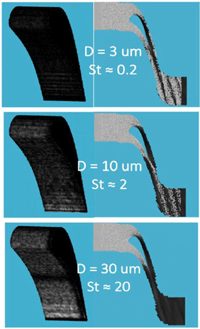Article contents
Physical aspects of CMAS particle dynamics and deposition in turboshaft engines
Published online by Cambridge University Press: 14 September 2020
Abstract

Gas turbine engines for fixed-wing or rotary-wing aircraft are operated in a variety of harsh weather environments ranging from arctic, volcanic zones, to desert conditions. Operation under these degraded conditions leads to the undesired entrainment of complex particulates resulting in drastic performance losses. Hence, there is a critical need to understand the governing mechanisms to inform the development of durable thermal and environmental barrier coatings. The objective of the current work is to present a novel multiscale physics-based approach to study two-phase flows that take into account the underpinning particle transport and deposition dynamics. Sessile droplet models are presented and used to compute the contact angle at high temperatures and compared with experiments. The study also investigates the sensitivity of deposition patterns to the Stokes number and the results identify local vulnerability regions. The analysis suggests that particle size distributions and the initial trajectories of the particles are critically important in predicting the final deposition pattern.
- Type
- Invited Paper
- Information
- Journal of Materials Research , Volume 35 , Issue 17: Focus Issue: Sand-phobic Thermal/Environmental Barrier Coatings for Gas Turbine Engines , 14 September 2020 , pp. 2249 - 2259
- Copyright
- Copyright © The Author(s), 2020, published on behalf of Materials Research Society by Cambridge University Press
References
- 10
- Cited by




